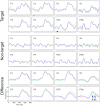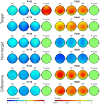Performance Analysis With Different Types of Visual Stimuli in a BCI-Based Speller Under an RSVP Paradigm
- PMID: 33469425
- PMCID: PMC7814000
- DOI: 10.3389/fncom.2020.587702
Performance Analysis With Different Types of Visual Stimuli in a BCI-Based Speller Under an RSVP Paradigm
Abstract
Brain-Computer Interface (BCI) systems enable an alternative communication channel for severely-motor disabled patients to interact with their environment using no muscular movements. In recent years, the importance of research into non-gaze dependent brain-computer interface paradigms has been increasing, in contrast to the most frequently studied BCI-based speller paradigm (i.e., row-column presentation, RCP). Several visual modifications that have already been validated under the RCP paradigm for communication purposes have not been validated under the most extended non-gaze dependent rapid serial visual presentation (RSVP) paradigm. Thus, in the present study, three different sets of stimuli were assessed under RSVP, with the following communication features: white letters (WL), famous faces (FF), neutral pictures (NP). Eleven healthy subjects participated in this experiment, in which the subjects had to go through a calibration phase, an online phase and, finally, a subjective questionnaire completion phase. The results showed that the FF and NP stimuli promoted better performance in the calibration and online phases, being slightly better in the FF paradigm. Regarding the subjective questionnaires, again both FF and NP were preferred by the participants in contrast to the WL stimuli, but this time the NP stimuli scored slightly higher. These findings suggest that the use of FF and NP for RSVP-based spellers could be beneficial to increase information transfer rate in comparison to the most frequently used letter-based stimuli and could represent a promising communication system for individuals with altered ocular-motor function.
Keywords: N170; P300; brain computer-interface (BCI); electroencephalography (EEG); famous faces; neutral pictures; rapid serial visual presentation (RSVP).
Copyright © 2021 Ron-Angevin, Medina-Juliá, Fernández-Rodríguez, Velasco-Álvarez, Andre, Lespinet-Najib and Garcia.
Conflict of interest statement
The authors declare that the research was conducted in the absence of any commercial or financial relationships that could be construed as a potential conflict of interest.
Figures






Similar articles
-
Different effects of using pictures as stimuli in a P300 brain-computer interface under rapid serial visual presentation or row-column paradigm.Med Biol Eng Comput. 2021 Apr;59(4):869-881. doi: 10.1007/s11517-021-02340-y. Epub 2021 Mar 20. Med Biol Eng Comput. 2021. PMID: 33742353
-
A novel hybrid BCI speller based on RSVP and SSVEP paradigm.Comput Methods Programs Biomed. 2020 Apr;187:105326. doi: 10.1016/j.cmpb.2020.105326. Epub 2020 Jan 22. Comput Methods Programs Biomed. 2020. PMID: 31980276
-
Motion-Based Rapid Serial Visual Presentation for Gaze-Independent Brain-Computer Interfaces.IEEE Trans Neural Syst Rehabil Eng. 2018 Feb;26(2):334-343. doi: 10.1109/TNSRE.2017.2736600. Epub 2017 Aug 11. IEEE Trans Neural Syst Rehabil Eng. 2018. PMID: 28809703
-
Advances in P300 brain-computer interface spellers: toward paradigm design and performance evaluation.Front Hum Neurosci. 2022 Dec 21;16:1077717. doi: 10.3389/fnhum.2022.1077717. eCollection 2022. Front Hum Neurosci. 2022. PMID: 36618996 Free PMC article. Review.
-
Brain-Computer Interface Spellers: A Review.Brain Sci. 2018 Mar 30;8(4):57. doi: 10.3390/brainsci8040057. Brain Sci. 2018. PMID: 29601538 Free PMC article. Review.
Cited by
-
Evaluation of Single-Trial Classification to Control a Visual ERP-BCI under a Situation Awareness Scenario.Brain Sci. 2023 May 31;13(6):886. doi: 10.3390/brainsci13060886. Brain Sci. 2023. PMID: 37371365 Free PMC article.
-
Brain-computer interfaces and human factors: the role of language and cultural differences-Still a missing gap?Front Hum Neurosci. 2024 Apr 11;18:1305445. doi: 10.3389/fnhum.2024.1305445. eCollection 2024. Front Hum Neurosci. 2024. PMID: 38665897 Free PMC article.
-
[Research progress of brain-computer interface application paradigms based on rapid serial visual presentation].Sheng Wu Yi Xue Gong Cheng Xue Za Zhi. 2023 Dec 25;40(6):1235-1241. doi: 10.7507/1001-5515.202305061. Sheng Wu Yi Xue Gong Cheng Xue Za Zhi. 2023. PMID: 38151948 Free PMC article. Chinese.
-
Evaluation of Different Types of Stimuli in an Event-Related Potential-Based Brain-Computer Interface Speller under Rapid Serial Visual Presentation.Sensors (Basel). 2024 May 22;24(11):3315. doi: 10.3390/s24113315. Sensors (Basel). 2024. PMID: 38894107 Free PMC article.
References
-
- Acqualagna L., Treder M. S., Blankertz B. (2013). Chroma speller: isotropic visual stimuli for truly gaze-independent spelling, in International IEEE/EMBS Conference on Neural Engineering, NER (San Diego, CA: ), 1041–1044.
LinkOut - more resources
Full Text Sources
Other Literature Sources
Miscellaneous

